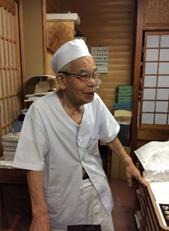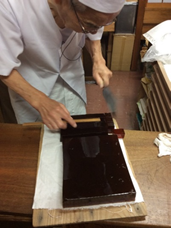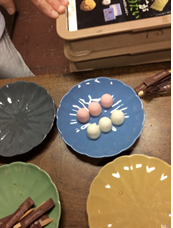Typical summer sweets in Kyoto from Kamehironaga
We visited Shintaro Nishii the head of Kamehironaga. He is the creator of the famous confectionery “Shitatari” that represents the summer of Kyoto. Just looking at the husband and wife makes we feel refreshed. I have never seen such a close couple. “I am now thanks to my family,” he says. The landlady also says, “I am thanks to my husband now.” It was a word that came out of the landlady who came home by chance. “We have never had a quarrel for 54 years since I got married. If we do that, it will affect the product,” said the landlord, “I am really happy.
 |
 |
 |
The owner seems to have been born for producing sweets, and he knows that he is an unrivaled sweets professional and research professional.
He told me about his life. Born in a farmhouse near the Ado River in Takashima, Shiga Prefecture, I wanted to make sweets since I was a kid. After going to Kyoto, a long-established Kyoto confectionery shop and Osaka confectionery shop, and then after a training at these shop
He trained at Kamehironaga and married the eldest daughter there.
In Kikusui-hokocho, Joo Takeno, a teacher of Senorikyu at the end of the Muromachi period, was the place where Daikoku-an was set up. It is also the origin of the tea ceremony, and Kikusuihoko has been conducting tea parties since the Showa era when it was revived. A few years after the revival, they commissioned Kamehironaga to invent the Japanese sweet “Shitatari” on Kikusui’s tribute about 48 years ago.
Kikusuihoko was named after the story of Chinese chrysanthemum, “Kiku Jido”. He was a long-lived man that he kept 700 years old with drinking the dew of chrysanthemums. By that reason it was named Kikusuihoko
The name “Shitatari” was named by Yoshitada Takahara, who was the priest of Yasaka Shrine. The calligraphy “Shitatari” on the confectionery wrapper is also written by the chief priest of Takahara. The raw materials are domestic brown sugar, water syrup, wasan bon, agar and it’s a clear amber-colored appearance and delicious taste.
“Shitatari” is a kind of Kankohaku, but its sweetness is finished with the ultimate ingredients such as brown sugar from Okinawa, fine granulated sugar, Awa’s finest Wasanbon, strong Tamba agar, etc. The In addition, matching with the groundwater of Kyoto, it has become popular throughout the year as a typical Kyoto confectionery that is unique to Kyoto.
